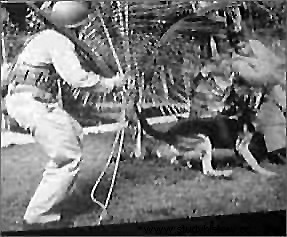After the US declaration of war against Japan in 1941, the government of Franklin D. Roosevelt decreed the transfer and internment of Japanese residents in the US – including second and third generation Nisei and Sansei respectively, with US citizenship – in resettlement camps. The suspicion that the attack on Pearl Harbor had received the help of Japanese residents in the US and the fear that citizens of Japanese origin would act as a fifth column, justified the creation of these camps. In 1942, the War Relocation Authority , the agency responsible for detention and transfer, had built ten camps in seven states and transferred more than 100,000 people to them. Parallel to the internment law, the War Department issued an order to discharge all soldiers of Japanese descent from active duty. As in Hawaii the citizens of Japanese origin accounted for more than a third of the total population, the internment measure did not have the same rigor as on the mainland and a few hundred remained in the Hawaiian National Guard. This small group was transferred to a camp on the mainland and there they had to pass hundreds of tests, prove their worth and swear to die for the United States. Twenty-five of them were transferred to Cat Island (Isla del Gato), in the Gulf of Mexico, to fulfill a secret mission

In November 1942, a training camp for Corps K-9 dogs was set up on Cat Island. (United States Armed Forces Dog Corps created in 1942). Unlike other training camps where dogs were trained to be used for surveillance, tracking or as messengers, on Cat Island they were trained to be attack dogs against the Japanese . This "brilliant » idea came from a Swiss refugee named William A. Prestre which claimed that he could train the dogs to attack only the Japanese -according to the handler, the Japanese had a different smell that the dogs could recognize- and it seems that the Army believed him. In addition, the choice of Cat Island to establish the training camp was not a coincidence, it recreated the climatic and vegetation conditions of the hundreds of Japanese Pacific islands.
The crazy plan -the canine version of Normandy- consisted of a landing on the Japanese beaches in which the greyhounds would be launched first, which due to their speed should destroy the nests of machine guns and mortars, then with German shepherd-type dogs that would cause the chaos among the Japanese ranks and, finally, a consignment of large dogs such as the Great Dane or the Alano that would cause great mortality. Later, the Marines would just have to finish the job. According to William Preste, he would need between 30,000 and 40,000 dogs to complete his plan.

When the field was prepared and the first consignment of dogs was sent, Preste, helped by several soldiers, began the first stage of his plan:to increase his aggressiveness. Once the first stage was completed, the most difficult challenge began... that they distinguish the Japanese and only attack them . And this is where the 25 nisei take center stage. that we had left aside in the first paragraph. As few Japanese prisoners of war were made, it was decided to pull from those they had in their own ranks; So, these 25 soldiers/guinea pigs were dressed in the Japanese Army uniform and for three months they were bait for the dogs. Ray Nosaka, one of the 25 «volunteers» , He says that, although they wore protection, they were often bitten by dogs; at other times, they hid and the dogs had to find them.

After several months of training, the officers asked Preste to prepare a demonstration to see the result of his training. Logically, the dogs were unable to distinguish the soldiers of Japanese origin from the rest . They gave him a second chance and, after another resounding failure, on February 2, 1943 they fired that fraud and canceled the canine invasion project. The 828th Signal Pigeon Replacement Company (for carrier pigeons) was moved to the island and the 400 dogs that had undergone the brutal training/punishment were re-educated to serve as harness dogs to transport the pigeons.

